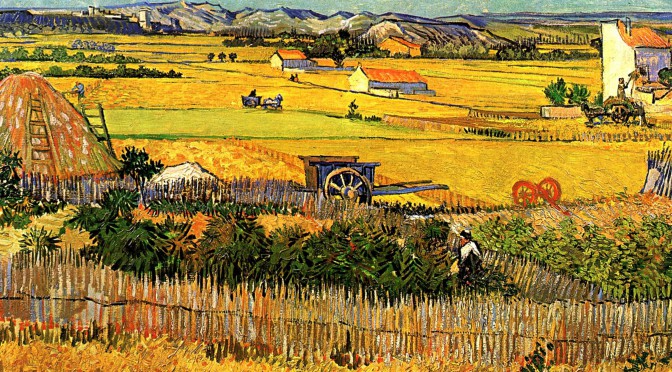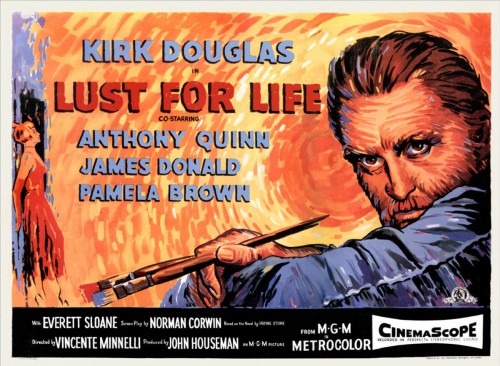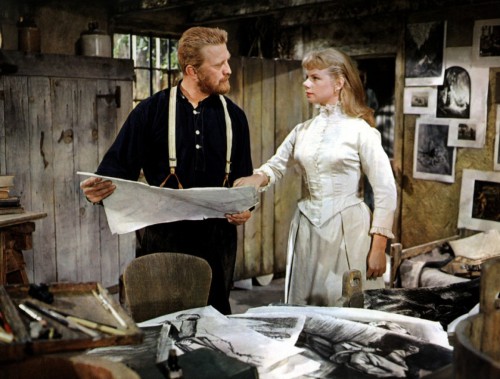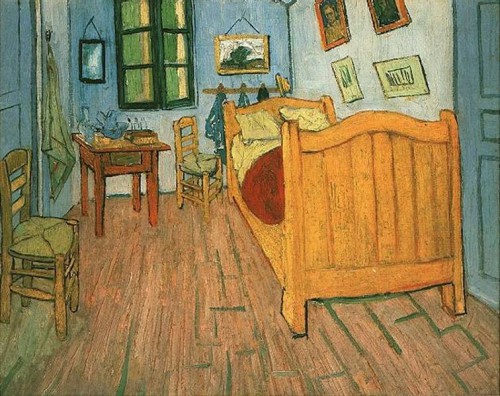In the days when movie biopics were romanticized versions of their subjects, usually straying far from the truth, out came Lust for Life, the 1956 film depicting the tortured life of Vincent Van Gogh, blazingly acted on screen by Kirk Douglas. This was a raw and honest portrait of the artist as non-conformist, alienating almost everyone he knew, a searcher for meaning in his life and for the calling that could bring out the only talent he believed he had, though few saw it in him. This might be considered a typical view of of an artist or musician today, but it was ground-breaking in 1956.
Kirk Douglas and his Bryna production company was eager to do this film, and his resemblance to the artist, magnified with a beard and dyed red hair, was uncanny. John Houseman had produced Moulin Rouge to great success, based on the life of Toulouse-Lautrec, which was released in 1951. Vincente Minnelli was the best director, really the perfect director, for Lust for Life. He had been a costume designer and set designer in Chicago and on Broadway, and considered leaving to study art in Paris before he was hired by MGM. He knew how to show the dynamic of both the inner conflict of the artist/individualist and the problems caused by trying to fit into a society. He knew the soul of the artist, and how to involve art itself into the fabric of film and film’s methods of storytelling.

The movie begins when Van Gogh is 25, aspiring to be a minister as is his father. The church elders reject his application, since he can’t even deliver a sermon without reading it aloud. One of the elders takes pity on him, seeing his earnestness, and tells him to go to the Belgian Borinage coal mines and do services there (apparently no else wants to). Once there he realizes that the downtrodden people need little preaching, and more real help, which the church doesn’t provide. He gives away his clothes and the allowance he gets from the church. Upbraided by the elders for looking and living like one of the miners, he calls them all hypocrites and leaves his church calling.
Once back home with his family, he argues regularly with his father. His brother Theo understands him the most, but tells him he should overcome his idleness. Kirk Douglas passionately responds, there are two kinds of idleness, and he only wishes he was the first, but as he says, “I’m in a cage of shame and self-doubt.”
He finds expression through drawing, which he shows his sister in the photo below. The art he favors is the depiction of common people in their daily life and in drawing the countryside. But his odd demeanor and unkempt looks prove an embarrassment to his family. He goes to the Hague where his uncle is an art dealer that provides him with paints. He paints in monotones – such pieces as The Weaver or The Potato Eaters. He suffers from unrequited love with his first cousin, then takes up with a prostitute for a while. Theo is now also an art dealer in Paris, so Vincent joins him there and goes to the Impressionists art show and he meets Impressionist and other painters like Pissarro (trust your first impression he tells Van Gogh), Seurat (it’s all about the science of color he says), and Gauguin.
And then Van Gogh heads to the South of France – to Arles, “everything there is gold, bronze, copper and yellow,” he says in his letter to Theo. He first rents a cheap room but then rents a big “Yellow House” that he wants to make the “Studio of the South,” or a commune for the artists he met in Paris – to live and paint and exchange ideas. But Van Gogh is too much of the strident personality, without social skills, for them to come. In the meantime he paints every day, often speaking to no one. Theo is providing the rent money, and he urges Gauguin to join Vincent so as to encourage him. Gauguin has the forceful personality and thinks he can make it work. A sojourn in the South of France is better than the hard life of a merchant mariner, which Gauguin had been.
So Van Gogh and Gauguin live together in the Yellow House, although it does not take long before their personalities clash, and when the weather turns bad or the Mistral winds blow the canvases of their easels, they are confined to painting indoors, which Van Gogh loaths. Gauguin can paint from memory. Van Gogh paints from observation and the feeling associated with it.
At the cafe in Arles, which they frequent and drink absenthe with regularity, Van Gogh painted the scene , “The Night Cafe.” Drinking the alcoholic absenthe was rumored to be addictive, and along with Van Gogh’s other mental issues, possibly bipolar disorder or Asperger Syndrome, fueled his strong reactions.
Van Gogh’s and Gaugin’s arguments led Gauguin to saying he was leaving Arles, which in turn caused Van Gogh to threaten him with a razor blade. This led to the off-screen scene where Van Gogh actually cuts off part of his own ear – perhaps in an effort to cut his own throat, or as self mutillation, no one knows. The preceding scenes are dramatically acted by Kirk Douglas, his physicality shows his distress, alternating between threatening and abject, in shame and in terror.
The photo below shows Kirk Douglas in the set rendition of the famous Van Gogh bedroom in the Yellow House in Arles, at Place Lamartine.
And as painted by the artist, the room was actually a trapezoid shape.
The ear episode ends up with more psychological trauma for Van Gogh – Gauguin leaves and Theo has his brother committed to an asylum, where Van Gogh sits days on end, saying or doing little. Eventually he returns to painting from his window, and then from the outdoors. A poignant scene has Kirk Douglas painting outside as a few of the inmates watch intently – a subliminal note by Minnelli on the power of art. But soon more psychological attacks follow, and Theo has him brought closer to Paris, to Auvers-sur-Oise, where he can be treated by Dr, Gachet. It is there that Van Gogh paints what is probably his last canvas. Wheatfield with Crows. It is indeed a foreboding work, dark skies, a road leading to nowhere, and the many crows, depicted in the movie as unintended subjects for the canvas, irritating Van Gogh to the point where he jabs black paint on his canvas in their shape, shortly before he shoots himself.
The screenplay for Lust for Life was written by Norman Corwin, using an episodic approach to Van Gogh’s life. As pointed out by Professor Drew Casper of the USC School of Cinematic Arts in the film’s DVD commentary, it has a five-part narrative which breaks down Van Gogh’s life into five parts, each structured around the letters he writes to Theo, which are narrated. The objective world as seen by Van Gogh is depicted in each of the five parts by at least one of his major paintings, separately seen. Each segment also had a color theme: black and gray in the Borinage; dark green in Holland; reds and blues in Paris; yellows and greens in the South of France; and multi-colored in Auvers.
The film was also richly complemented by the excellent costume designs of Walter Plunkett. Plunkett was one of the few designers that was equally adept at designing for both men and women. He conveyed the careless but individualistic dress of Van Gogh as well as the equally individualistic but almost dandy-working man dress of Gauguin – with his flashy and decorated vests and jackets – a purposeful magnet for the ladies. Walter Plunket also conveyed the full panoply of late 19th century France – the farmers and peasants, the red and blue soldier uniforms of the Zouaves, the decorated uniform of the facteur Roulin, the uniforms of the band, the traditional folk costumes of the women of Arles. All of this was of course accomplished through careful on-location research. The filming itself was mostly on-location in Holland, Belgium, Auvers, Arles, and the South of France. The cinematography of Freddie Young adds depth and beauty to the film.
The musical score composed by Miklos Rozsa evokes the settings and the emotions of the painter in a masterly way. Themes and moods are heightened by Rozsa’s compositions, conveying inner feelings of romance, pain, inertia, seizures, and even brief periods of contentment at painting in the plein-air.
Kirk Douglas said in his autobiography, The Ragman’s Son, that in performing the role of Van Gogh in Lust for Life, “It was the most painful movie I ever made.” And it took him a while to get over the role and the psychological effect it had on him. Douglas was nominated for Best-Actor for his role as Van Gogh, his third nomiation. Anthony Quinn was nominated for Best Supporting Actor. Everyone kept telling Douglas that he was a sure thing to get the Oscar. It was his third nomination after all, and there was little competition. He was in Munich Germany when the Academy Awards were held, making Paths of Glory. He said he had even practised looking surprised for all the photographers waiting in the lobby at his hotel. He was indeed surprised when he learned that Yule Brynner won for his role in The King and I. Anthony Quinn, however, won for Best Supporting Actor, the only award winner in the film.
Perhaps voters thought he over-acted. It is certainly a style of acting not much seen today. Lust for Life leaves an indelible image of the actor and of Van Gogh, a raw, powerful image as powerful as the canvases Van Gogh painted himself.
Views: 1127












Very informative piece. Thanks for writing it! Saw the film yesterday and was looking for info!
Thanks for the comment Gustavo. I hope you found the post informative.
Loved this post! Insightful comments, beautiful screenshots, and great background information! I’ve written about KISMET, the movie Minnelli was working on just before making this one. Apparently he neglected KISMET in his haste to start working on LUST FOR LIFE! I can see why!
Thanks for the comment Blonde at the Film. This film really was right for Minnelli and he felt very strongly about it as an artist himself. As you point out – it shows why.
Wonderful as always, Christian. I love your eye for detail, whether in description or selecting photos to accompany the post.
Great to hear from you Classicfilmboy.I’m glad you enjoyed the post on Lust for Life, a great classic film featuring beauty and pain in equal measures.
I absolutely LOVED this, Christian. When I first knew you chose LUST FOR LIFE (and thus left me to find a connection to a film of my own to write about for this blogathon), I was trying to figure out the motivation behind your choice. Now I see just how many there are. This wonderful post made me think of your analysis of AN AMERICAN IN PARIS–also by Minnelli–where painting and film and costume design so perfectly intersect. You do such a great job of illustrating that. LUST FOR LIFE is indeed difficult to watch because of the subject matter and because Kirk does such an incredible job at showing Van Gogh’s madness (he was ROBBED of that Oscar), but it’s a film that I have warmed to over the years. You have made me appreciate it all even more. Bonus–I did not know Minnelli himself was a costume designer! I should have known! Thank you for such a beautiful post on this film.
Thanks Kimberly – I’m glad that you appreciate it more now. As you say, its not an easy film to watch. One can imagine what Kirk Douglas went through, and we can feel how he identified with the painter as he played this role. Minnelli made sure they were on location where they wouldn’t be interfered with by the studio. Even with Kirk Douglas in the lead role, a movie about a mad artist was not going to be a big hit.As you point out, it was its blending of art and costume and set design in film, a Minnelli strength, that appealed to me. And I knew you could find a connection through Minnelli, if no other, to some strong film candidates.
Wonderful piece highlighting many of the details that make “Lust for Life” such an important movie.
We learn about how the mind works every day. How much of Van Gogh’s artistic soul was wrapped up in his tortured mind? What would peace have brought to his work or taken away? Douglas positively makes you ache for the man.
Thanks CaftanWoman. I think his psychological makeup gave him the intensity and drive to paint no matter what. If nothing else,
this turned into not only the number of painting he produced during his short productive years and their very style. That certainly is depicted on screen.
You did a wonderful job covering the many facets of this gorgeous, intense film, Christian. As a rule, I’m not a fan of biopics, but “Lust for Life” is a far cry from most films of the genre. Minnelli deserves the lion’s share of the credit for the movie’s magnificence, I think. As you say, he was the “perfect director” to mount “Lust for Life.” Like most of his films, it’s a top-of-the-line production in every way.
Van Gogh’s art has such vibrancy and emotional power…he was able make an image to stir and delight the soul of a subject as mundane as a sidewalk cafe at night.
I’m with you on the biopics Lady Eve, especially those from the studio era. They were so idolatrous. Jean Negulesco
was another director considered for the film before it was sealed by MGM. He was also an artist and would no doubt have done a good job with it. But Minnelli was ideal, and I think Kirk Douglas should have won the Oscar.
Today’s Build-Your-Own Blogathon featured post is the Vincent Van Gogh bio LUST FOR LIFE reviewed by @CEsquevin at http://t.co/CR56sNbUcM
This is such an intense movie, and Kirk Douglas is larger than life in it. There is so much to admire about it, as you’ve pointed out. The costumes, the sets and the casting are superb. Maybe Douglas is a bit over the top, but I think it draws us further into Van Gogh’s world and his anguish. Terrific post!
Van Gogh is my favorite painter and Kirk Douglas brings a vital passion to the role. I’ve read where the color process used for this film faded over time, so its images were once even more vibrant. It still looks fabulous. By the way, “Cafe Terrace at Night” is my second fave Van Gogh painting (yes, I’m among the millions that love “Starry Night.”
Thanks for your comment Rick. Van Gogh is one of my favorites and I love the Night Cafe. The Anscocolor/Metrocolor process was a “one-strip” color film process that was touted as being better than Technicolor. It likely has lost its color value over time and is ripe for restoration. Imagine what it could look like if it really was better and crisper that Technicolor.
Today’s Build-Your-Own Blogathon featured post is the Vincent Van Gogh bio LUST FOR LIFE reviewed by @CEsquevin at http://t.co/1IhJlFDtVw
A sojourn in the South of France is better than the hard life of a merchant mariner – That’s my motto! A beautiful post, Christian – almost as gorgeous as the movie and the paintings. Lust for Life is dramatic, but so was Vincent. it is a beautiful work of art – a high mark for all involved.
Thanks FlickChick – I can go for that motto myself. I can only imagine what Van Gogh would think if he saw
the prices his paintings sold for today. He is one of my favorites.
Thanks Silver Screenings. I think Kirk Douglas played the role as it should be played. He was at times manic and at times lethargic and depressed. Although Minnelli didn’t give very specific instructions to his actors, this was no doubt how he saw the role as well.